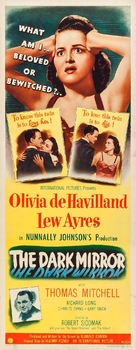
Today is Sunday, so it is time for another article in our series about new Code movies, 52 Code Films. Every week this year, I watch and review at least one movie from the American Breen Era which I have never seen before. This week’s article will be the last one in this series which I publish in July, #CleanMovieMonth85.

Today’s topic is The Dark Mirror from 1946. This weekend, The Noirathon is being hosted by Maddy Loves Her Classic Films in honor of the film noir genre, one of the most iconic and beloved genres of the 1940s and 50s. I decided to participate in this blogathon with my new Code film for this week. I thought that this would be a good opportunity to watch and review a movie I have been wanting to see which is free on Prime Video, The Dark Mirror. I watched this movie on Saturday, having beforehand confirmed it to be a film noir, so this is my entry in the Noirathon.
Plot
A doctor is found murdered in his apartment at night. Two witnesses saw a beautiful young woman going to and coming from his apartment around that time. The deceased’s secretary identifies the described woman as her late employer’s girlfriend, who works at a candy stand in the medical building. The witnesses identify her as the woman they saw, but she has a strong, corroborated alibi. How could she have been in the victim’s apartment and walking in the park at the same time? The detective who is bound on solving the case is baffled until he discovers that the suspected has an identical twin. No one in the medical building knew that the woman at the candy counter was actually twins, including the doctor who courted and was killed by one of them. The two women make a pact, refusing to tell which of them was in the park that evening and which stayed at home. The detective knows that one of them is a murderess, but unless he can determine which was seen leaving the apartment, he can’t prosecute either of them. He enlists the aid of a psychiatrist who also works in the medical building and liked the young woman, not knowing she was twins. The doctor agrees to help, since studying the psychological and personality differences of identical twins is his specialty. He agrees to study them both and try to see which of them is capable of murder so that he can tell the detective, not for legal reasons but for his own personal knowledge. The psychiatrist approaches the two girls about participating in his study of twins, insisting that it has nothing to do with the case. The one sister is very confident and eager to participate in the tests, since she is attracted to the doctor. The other is nervous, since she suspects the doctor of having ulterior motives. However, they ultimately agree, prompted by the money and the fact that they liked him. As he delves into their innermost thoughts and feelings with his tests, he realizes that one is a kind, sympathetic girl, and the other is an insane killer. Can he discover and reveal which is which before it is too late?
Cast
The twins who are suspected of murder are Terry and Ruth Collins, both played by Olivia de Havilland. The psychiatrist who studies them is Dr. Scott Elliott, played by Lew Ayres. The detective who is intent on cracking the murder case is Police Lt. Stevenson. The elevator operator who admires the twins is Rusty, played by Richard Long. The witness who saw one of the Collins sisters going to the apartment is George Benson, played by Lester Allen. The witness who saw her coming from the apartment is Mrs. Didriksen, played by Lela Bliss. The doctor’s secretary is Miss Beade, played by Marta Mitrovich.
Production Notes
This film was directed by Robert Siodmak. It was produced by Nunnally Johnson. The production company was International Pictures, and Univeral Pictures distributed it. The screenplay was written by Nunnally Johnson, based on an original story by Vladimir Pozner. This film was nominated for an Academy Award for Best Original Story for Vladimir Pozner.
Code Compliance
This is a good Code film. I was very pleased by the fact that this movie addresses crime topics without violating acceptability at all. There is no undo violence or offensive elements. Delicacy and restraint are used at all times, and the work is very mysterious and dramatic as a result. Suspense is created by not showing things rather than by showing things. I appreciated the fact that this movie was a dramatic mystery which obeyed the Code while depicting a riveting story about twins who look exactly the same but have a huge difference in character.

My Opinion
I really liked this film. I thought that the premise was absolutely fascinating and very unique. The script and filmography did an excellent job of revealing little facts bit by bit, keeping the audience in suspense for a long time. I was extremely impressed by the special effects used in regard to the twins. If I hadn’t known otherwise, I would have been sure that there were two actresses playing the Collins sisters. That leads us to the acting, which is marvelous. Olivia de Havilland does such a good job creating the dual roles, showing the obvious and subtle differences between them throughout the film. I was also very impressed by Lew Ayres’s performance in this movie. This was his first film after his four-year absence from Hollywood during World War II. Lew Ayres is one of my favorite actors, and I love his pre-war films. However, I didn’t think I wanted to ever see his work after the war, since I feared that his boyish charm and youthful handsomeness would be lessened in his later thirties. Thus, I planned to never watch this movie. However, since then, I have come to appreciate the maturity which comes with age and to admire the handsomeness of actors in their forties and fifties, losing my aversion to seeing later Lew. Since Olivia de Havilland is one of my favorite actresses, I decided that I just had to see their only film together. I am so glad that I did. He is just as handsome, charming, and talented in this film as he was in his 1930s films. The rest of the cast is also excellent.
Recommendation
I highly recommend this film to my readers. It is a masterpiece! I know that mystery, crime, suspense, and film noir fans will especially like it. However, it is not too creepy or dark for viewers who are not as fond of those elements in film. I know that fans of Olivia de Havilland and Lew Ayres will enjoy this movie because of its great showcase of those stars. It is amazing how much is packed into this relatively short film. It is under an hour and a half in length, but I can’t imagine its being any more captivating or dramatic if it were longer. It would have been very interesting to see the complications and situations which are arose at the medical building when everyone mistook the twins for one person, but it is just as good to hear references to that time and imagine how it must have been. Oftentimes less is more.
For the Blogathon
I haven’t watched many films noir, but I truly like this one. The Dark Mirror disproves the common notion that the film noir genre violated the Code, reflecting the weakening of the Production Code Administration after World War II. Under Joseph Breen’s watchful leadership, the PCA was as strong as ever in the late 1940s, and Code-compliance cannot be generalized throughout a genre. It must be analyzed film by film. Films noir were to the 1940s what gangster films were to the 1930s. They often focused on crime and violence, so there featured the potential for Code-violation. However, many of these movies were handled with the great tact and delicacy which characterized the Breen Era. The Code did not forbid darkness, nor did it forbid the depiction of crime and sin. However, it did forbid films to condone crime. It also forbade the depiction of crime which would inspire imitation. Crime must not be glamorized, and sin must not be presented attractively. Modern viewers are much too hasty to read more sinister or racy themes into films than may really be present because they are viewing them through tainted modern eyes. Also, one must always remember that the cornerstone of the Code was the fact that viewers were allowed to believe what they wanted to believe about films and their characters. When you are watching a Code film, noir or otherwise, you are often given the choice of believing or not believing that a situation is immoral. Importantly, it is so subtle that there is no proof that it is immoral. I hope that classic film fans can view films noir with the Code in mind and see them in a new light.
Happy #CleanMovieMonth85!
By the way, please join our month-long celebration of Code films, #CleanMovieMonth85! Throughout July, we are going to watch nothing but American Breen Era films, and we are inviting participants to do the same. Writers can join this celebration with articles about their own favorite films and discoveries during the month, and we will republish them on our website. Here’s to 85 years since the formation of the Production Code Administration!
Click the above image to buy this movie on DVD at Amazon and support PEPS through the Amazon Affiliate program!
This week, I only watched this one new Code film.
Follow us to bring back the Code and save the arts in America!
We are lifting our voices in classical song to help the sun rise on a new day of pure entertainment!






This is a very good film. I’m always impressed by Olivia’s duel performance when I watch this. I’m so glad you enjoyed it. I hope you feel able to watch more Noir films after this. Thank you so much for joining me for this blogathon, Tiffany.
I’d also like to say that I really enjoyed watching the video of the debate you were involved in about Pre-Code vs. The Code. Great discussion. I was very impressed with how you handled the question and answer session. While I’m still not a fan of the code and still see it as censorship, I do agree that it did allow family films to be made which didn’t contain upsetting or unpleasant things. Have you considered making videos for your blog where you discuss the code or answer followers questions about it? Might be fun.
Maddy
LikeLiked by 1 person
Dear Maddy,
Thank you so much for including my article and for your kind and encouraging words about my video. I may add videos to my website. It could be a stimulating addition!
Yours Hopefully,
Tiffany Brannan
LikeLiked by 1 person
Pingback: The Noirathon Begins – Maddy Loves Her Classic Films